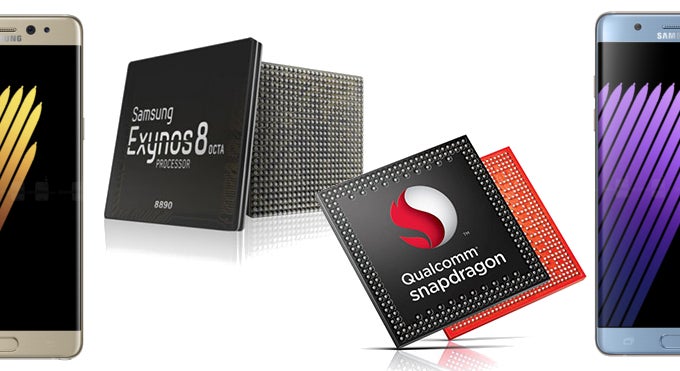Samsung Galaxy Note 7 Snapdragon 820 vs Exynos 8890: the beasts clash

Now, if this isn't your first rodeo, you probably know that Samsung tends to release its flagships in two variants – one powered by a Qualcomm-made SoC, usually for the US market, and one powered by Sammy's home-brewed Exynos chipset for everywhere else. In the case of the Note 7, we have the Snapdragon 820 on US-bound units and the powerful Exynos 8890 for the international variant. If that sounds familiar, here's a hint: the Galaxy S7 and S7 edge that launched earlier this year are available in variants with the same two chipsets.
| Qualcomm Snapdragon 820 | Samsung Exynos 8890 | |
| CPU | Quad-core (Kryo) Clock speed: up to 2.15 GHz | Octa-core (Samsung M1 + Cortex A53) Clock speed: up to 2.15 GHz |
| GPU | Adreno 530 Core speed: 624 MHz | Mali-T880 MP12 Core speed: 650 MHz |
| Memory | Dual-channel LPDDR4 Speed: 1866 MHz | Dual-channel LPDDR4 Speed: 1794 MHz |
A quad-core vs an octa-core? Yes, it's a bit hard to imagine that Samsung would be able to pull that off without some discrepancies between the Snapdragon and the Exynos editions' performances, so — of course — you are probably wondering whether there are some major differences in performance.
Well, we've got you covered, as we ran our go-to benchmarks on both the European and US variants of the Note 7. All tests were ran three times and the scores below are the average from each run. Here are the results:
A mixed bag of results
The Snapdragon still wins when it comes to graphics performance
There is no doubt that the two chipsets are among the most powerful on the market, and we expected some great scores from both. What we didn't expect to see, however, was the huge difference gap in AnTuTu and Vellamo Metal — the Snapdragon 820 absolutely crushed the Exynos 8890 in both of these CPU-heavy benches. However, moving on to Vellamo Browser and JetStream, we see that the Exynos regains some footing and performs unwaveringly better when it comes to web-browsing.Next come the graphics-intensive tests, and, again, we have a huge difference in performance on the heavy, heavy GFXBench Manhattan test — the performance of the Snapdragon 820 with its Adreno 530 GPU reached almost twice the score of the Exynos 8890 with the Mali-T880 graphics chip. Moving to the much more forgiving T-Rex, however, we get a steady performance of about 53 FPS on both phones — more than enough.
Before we reach the end of the tests, we move on to the “overall performance” Basemark OS II benchmark. Here, both phones are relatively equal, though the Exynos edition does seem to have an edge. Last, but not least, we run them through Geekbench 3, which measures CPU performance for single-core and multi-core use. Here, the Exynos 8890 wins out as well — while both processors do equally good in the single-core test, the Sammy-made octa-core chip soars higher with about 1,200 points over the Snapdragon 820 in the multi-core test, giving it a not-so-slight edge.
In the end, what does it all mean?
Whether you get the Exynos or Snapdragon 820 variant Galaxy Note 7, you should expect (and get) a beast of a smartphone. If we had to draw conclusions, we'd say that yes, the Snapdragon 820 will probably make graphics junkies a bit happier – at least according to the synthetic benchmarks above. The Exynos could potentially be a bit snappier in other daily jobs, such as browsing the web, opening specific apps, or maybe, possibly multitasking.
Should you be losing sleep over the performance differences in the two variants? We'd say, for real world application — hardly. Of course, there's also the question of which model (if any) has a longer battery life. Well, stay tuned!
Follow us on Google News



![Some T-Mobile users might be paying more starting in March [UPDATED]](https://m-cdn.phonearena.com/images/article/176781-wide-two_350/Some-T-Mobile-users-might-be-paying-more-starting-in-March-UPDATED.webp)










Things that are NOT allowed:
To help keep our community safe and free from spam, we apply temporary limits to newly created accounts: